IEEE Dynamic Spectrum Access Workshop in DC 9/19/11

The IEEE Communications Society will sponsor a workshop on dynamic spectrum access (DSA) technology and related policy issues in Washington on 9/19/11. IEEE states:
“This workshop brings together thought leaders from the government, regulatory bodies, Department of Defense, industry, standards bodies, and academia to discuss and identify inter-disciplinary opportunities and challenges in dynamic spectrum access wireless networking. This unique workshop program contains only interactive panel sessions in order to foster collaborative discussions among the participants. Break-out sessions also provide a forum for one-to-one interaction.”
The program is now available and registration is open.
Petition Filed to Stop Contraband Cellphone Use in Prisons
The topic of illicit cellphone use in prisons has been a recurring topic here even though there has been no explicit FCC action on the topic other than a workshop almost a year ago. Indeed, while FCC waited over 2 years to ask for any public comment on CTIA’s November 2, 2007 petition on cellphone jamming and customer-owned bidirectional amplifiers, it has so far ignored all the jamming issues in that petition - both prison-related and otherwise. (The Docket 10-4 public notice seeking comment on this and other petitions avoids all mention of jamming issues of any type and focuses solely on the amplifier section of the petition.) But FCC is being somewhat even handed here: They have ignored both CTIA’s attempt to have all jammers declared illegal and the July/August 2009 petition of the South Carolina Department of Corrections and 30 other states to allow jamming in prisons to control illicit cellphone use. Except for the above mentioned workshop, FCC has taken no visible action to control cell phone use in prisons. (Of course, being caught between the powerful CTIA and state governments is not a desirable place to be.)

Carl Lackl, Jr. (l) a Baltimore witness murdered as a result of a prison cell phone call.
Capt. Robert Johnson (r) South Carolina Department of Corrections, shot 6 times
at his home as a result of a prison cell phone call.
The GTL petition addresses both jamming and “managed access” - interception and blocking of calls based on their location and possibly with a “green list” of cellphones that may make calls at or near prison property. The petition states,
“Managed access systems are generally favorably viewed, yet they are too costly for most deployments and complicated to authorize given the need to negotiate spectrum sublease agreements with multiple wireless telecommunications carriers. This petition presents a proposal to amend the Commission’s rules to streamline the spectrum lease process so that spectrum lease agreements, when needed, are obtained in a shorter period of time.”
It also seeks to clarify the obligations of a managed access system with respect to E-911 services and involve the local PSAP operator in determining what is appropriate for a given area.
Finally it asks the Commission to finally act on determining whether CTIA’s interpretation of Section 333 (that the Commission does not have the authority to permit jamming by non-federal entities) is consistent with the statute. It argues that FCC should consider the legislative history of Section 333 as well as the plain reading of the Communications Act that whatever Section 333 means it must apply equally to both FCC and NTIA since it does not differentiate between the two agencies. (Section 305 exempts the President and NTIA from Sections 301 and 303, but not from the rest of the Communications Act. Also, Section 333’s contemporary on satellite jamming, 18 USC 1367, specifically excludes “any lawfully authorized investigative, protective, or intelligence activity of a law enforcement agency or of an intelligence agency of the United States” while Section 333 is silent on this point.)
Let’s hope that FCC finds this petition in its inbox and takes some action on this important issue that has been ignored for so long. Sources in FCC report that there is no centralized tracking of petitions that are received but have not been put out for public notice. So even the 8th Floor may not be aware of this petition and its issues.
UPDATE
On 9/6 CellAntenna Corporation filed a related petition with FCC. So FCC now has 3 petitions dealing with various aspects of contraband cellphone use in prisons, ALL without any action.
The CellAntenna petition would “require CMRS carriers to do their part and suspend service to any wireless device reported to be operating in a correctional facility within one hour after receipt of notice from a Warden”. Of course, this approach could allow any smuggled cellphone to be used at least once and would be a boon to contraband smugglers.
So isn’t it time for FCC to at least put some of these petitions on public notice for comment?
How Do You Count to 500?
On February 24, 2010 Chairman Genachowski announced in a speech at the New America Foundation:
“First, we are going to announce a gameplan to unleash more spectrum for mobile broadband. The National Broadband Plan will set a goal of freeing up 500 Megahertz of spectrum over the next decade. We will work closely with NTIA to do so.”
CTIA had previously stated
So the 500 MHz no doubt was a compromise number that attempted to address reality.“we need at least another 800 MHz within six years to meet the increasing consumer demand whether it's for mobile Internet, mHealth, smart grids, or a number of other wireless uses that change the way we live and work."
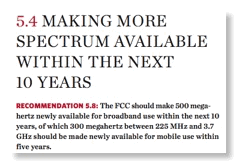
Traditionally the cellular industry has used full duplex symmetrically pair spectrum. Thus the cellular 800 MHz band is 824-849 MHz (mobile-to-base) paired with 869-894 MHz (base-to-mobile). The same type of symmetric pairing was used for PCS and 3G in high bands. This was clearly necessary when the predominant use of cellular was 2-way voice which has little tolerance of time latency/delay. But the rapid expansion of mobile communication volumes predicted by CTIA and the NBP are not 2 way voice, rather they are Internet and video related - categories that are asymmetric in information flows and more tolerant in time latency. Many of these flows are also highly intermittent as compared to voice, with high peak to average data rates. Is the traditional type of allocations the best way or the only way to handle this type of growth?
Your blogger has no objection to the reallocation of 500 MHz of spectrum for the traditional paired symmetric use, but it is becoming increasingly clear to all involved that finding 500 MHz of such spectrum will be in the extremely difficult to nearly impossible range. In addition, the major need for spectrum is in major metropolitan areas and the focus on nationwide availability of spectrum ignore options. From what I have heard, the cellular establishment wants FCC and NTIA to find it spectrum that has all the following characteristics:
- Nationwide full time availability
- Paired
- In large contiguous blocks
- Consistent with international allocations and international standards (note that this is not a legal requirement except near borders with Mexico and Canada absent a bilateral agreement)
So isn’t it time to start thinking of Plan B? If 500 MHz of spectrum meeting the cellular establishment’s 4 conditions can not be found with politically acceptable impact on other federal and nonfederal uses, how would “noncomplying” spectrum count towards the 500 MHz goal? Maybe for tactical reasons the cellular establish doesn’t want to consider this possibility, but to many of us it is a quite real possibility as none of the “spectrum haves” are anxious to release their part of the 500 MHz or have any impact from its altered use, e.g. GPS/LightSquared problem.
CBO knows how to “score” budget proposals, should FCC and NTIA start thinking about how to “score” spectrum reallocations with respect to the 500 MHz goal?
[I help my international neighbors by reading in English to their 4 year old. While I was writing this post, one of the books he selected was this one.I recommend it!]
Seismicity & Telecom Network Vulnerability
Today’s magnitude 5.8 earthquake in the Washington area came just as I was putting my thoughts together on seismic risks and telecom networks. This was in part inspired by my May trip to Japan, including Tokyo and Sendai, and discussions and observations while there. (During the Vietnam War my military service dealt with underground nuclear test detection so seismic issues are not entirely new for me.)
While we usual think about seismic threats as only applying to California and Alaska, so very large earthquakes have occurred elsewhere during the history of our country. These include the 1811 magnitude 7.7 New Madrid (Missouri) earthquake and the 1886 magnitude 7.2 Charleston (South Carolina) earthquakes. Thus there is a real risk of a major earthquake in lots of places although with a small probability.
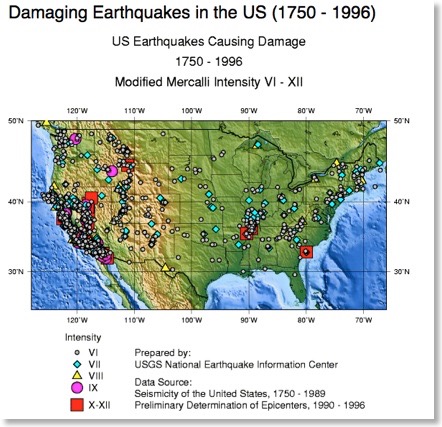
I am concerned that the telecom industry and regulators have not connected this fact with the large scale phasein of fiber optics as the dominant long haul communications technology as well as a key factor in cellular backhaul. In the past, long distance microwave had a major role in this area and that is diminishing. Microwave systems can be readily made earthquake resistant by strengthening the towers that hold the antennas and the nearby equipment buildings.
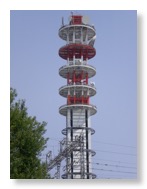
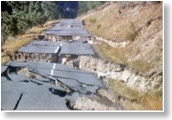
In an earthquake that results in ground fissures, fiber optic lines miles apart could suffer related damage so an analytical assumption that they are independent would be wrong. Realistically, fiber facilities sometimes end up in the same conduit so independence of reliability can be more suspect.
During the Cold War the Pentagon took actions with FCC to influence network design first to improve reliability in a post nuclear attack scenario and later to inhibit microwave interception by the Soviets. The former was done under the AT&T monopoly, but the later was done after the onset of real competition for AT&T.
While such direct government intervention into network design might not be appropriate in this case, it appears that there is no hard data on the relative use of fiber versus microwave for long haul transmission (or cellular backhaul) in areas with a risk of large earthquakes. Perhaps industry and the appropriate federal agencies should open a dialogue on the topic.
Retrospective Analysis at the FCC
The title of this post was also the title of a 8/9/11 post by Ruth Milkman on the FCC’s own blog. It describes FCC implementation of a 7/11/11 Executive Order entitle “Regulation and Independent Regulatory Agencies” -- which it oddly did not give a link to it or even its EO number - 13579, as shown above. (See, SpectrumTalk is nicer to its readers than FCC’s blog!)
The core of EO is the following:
To facilitate the periodic review of existing significant regulations, independent regulatory agencies should consider how best to promote retrospective analysis of rules that may be outmoded, ineffective, insufficient, or excessively burdensome, and to modify, streamline, expand, or repeal them in accordance with what has been learned. Such retrospective analyses, including supporting data and evaluations, should be released online whenever possible.
This policy is similar to the Carter Administration’s Executive Order 12044 that I have previously written about here and that was the initial impetus to what became Wi-Fi and Bluetooth. Regulation of a dynamic technology such as wireless technology is bound to become anachronistic and need updating. This need for updating in turn leads to delays for new technology and discourages capital formation for new technology. As Mitch Lazarus has written in comments in the “Wireless Innovation NOI” (which has seen no Commission action in over 2 years!),
Often a radically new technology comes from a small, privately-funded start-up. Its only product may be the one awaiting Commission approval. These companies may lack the resources to survive a lengthy FCC proceeding.
Several FCC sua sponte deregulatory spectrum initiatives that I initiated have resulted in product development that has stimulated economic growth. Such initiatives are not popular with industry insiders and conservative FCC staffers who prefer focus on the the spectrum analog of “no one ever got fired for buying IBM”. Here are some specific initiatives and their impact:
- Docket 81-413 - Wi-Fi, Bluetooth, and ZigBee
- Docket 83-114 - via successor Docket 85-171 resulted in technical deregulation for Part 90 modulation and bandwidth
- Docket 94-124 - 60 GHz products such as 802.11ad
- Docket 96-35 - permitted flat microwave antennas implicitly forbidden by previous rules
- Docket 02-146 - commercialization of 70/80 GHz bands
Ms. Milkman writes in the FCC blog,
The President's directives are consistent with the values and philosophy we apply here at the FCC. In a press conference following the release of the July 11 Executive Order, Cass Sunstein, the head of the Office of Information and Regulatory Affairs in OMB, noted that the FCC has a robust regulatory review process in place. Under Chairman Genachowski's leadership, we are proud of the progress we have made so far.
I do not disagree with much of what she writes, however, there are real limitations to the 47 USC 161 biennial review process that I think she was referring to. The statute refers to review of “all regulations issued under this chapter in effect at the time of the review that apply to the operations or activities of any provider of telecommunications service”. In the past, the Commission has interpreted Section 161 in the narrowest possible sense to limit its work. Indeed, I recall during the Powell chairmanship numerous efforts were made by upper commission leadership to limit the scope of biennial review and keep it as narrow as possible so it would not be a distraction to the current agenda.
For example, I filed comments in the 2008 review. Perhaps these were brilliant comments, perhaps not. What happened to these comments? Well, in July 2010 when the results of the biennial review were released - a time during the Genachowski chairmanship - FCC dismissed the comments based on a narrow interpretation of the statute stating,
" the comments did not suggest that the rules should be repealed or modified because they are no longer in the public interest as the result of meaningful economic competition between telecommunications service providers. Accordingly, OET concluded that these comments were beyond the scope of the section 11(a) review".
Thus a narrow interpretation of Section 11(a)/47 USC 161(a) was seen as a preferred alternative to considering the merits of the suggestion!
This I have submitted to the FCC blog a comment stating that if they are serious about “retrospective analysis” they could start by looking at ALL the biennial review proposals in recent years that were dismissed for such bureaucratic reasons and consider them on their merits - not narrow interpretations of Section 11! But while we at at it, how about some action on the Wireless Innovation NOI (09-157)?
Prof. Paul Meier (1924-2011):
Interesting People Met During My FCC Career

Meier was well known among his colleagues for co-developing a statistical method called the Kaplan-Meier estimator, which provided a novel method for estimating survival rates in clinical trial data. It incorporates data from patients who have been followed until death, as well as others who survived. The journal article that introduced the method in 1958, co-authored by Meier and Edward L. Kaplan, remains one of the most cited research papers in statistics or any other field, with about 34,000 citations to date. Meier also wrote extensively about the polio vaccine trial of 1954. The trial comprised the largest medical experiment in history, involving more than a million children.
But you could ask what did this have to do with FCC? Prof. Meier was hired by FCC as a consultant to help in U.S. v. Haynie, the prosecution of the 18 USC 1367 “Playboy jamming” case - the felony prosecution under that statute that was passed after the 1986 better known “Captain Midnight” satellite jamming case. In both cases, an FCC/FOB team that I am proud to have participated in, unmasked the perpetrator in about a week despite the unprecedented nature of the incidents. (FOB was the predecessor of today’s Enforcement Bureau and my presence there for what turned out to be about to be 7 years was “internal exile” resulting from the controversies involved in creating what became Wi-Fi and Bluetooth.)
“Captain Midnight” quickly agreed to plead guilty to a misdemeanor violation of 47 USC 301, “transmitting without a license” even though there was a legal question whether that statute was applicable. The satellite industry was concerned about the possibility of more jamming and possible damage to satellites through input overloads and urged Congress to pass a new felony statute which became 18 USC 1367.
Thomas Haynie, an employee of the Christian Broadcasting Network’s satellite uplink station in Virginia Beach was accused of the crime and CBN paid for his defense. At the time of the incident, CBN leader Pat Robertson was running for the Republican presidential nomination. As reported earlier here, US Attorney (now Judge) Henry Hudson tried to avoid this prosecution for a new felony statute where the offense occurred in his district and the prosecution was handed over to the Justice Department’s Criminal Division.
James Wilson, the excellent prosecutor assigned to the case wanted an ironclad case to nail the conviction. The basic evidence consisted linking Haynie to the event consisted of my analysis of a tape recording of the event showing that the text in the jamming signal was a very close match to the the character generator unit at CBN and different that most other units of the same model due to manual adjustment internal to the device. Similarly event tape showed the transmitter used for the jamming started at partial power and 1.67 seconds later went to full power - a characteristic of a certain transmitter model that CBN had and a very close match to the turnon time delay of CBN’s transmitter.
Prof. Meier was engaged to do a statistical analysis of the data we collected, advise on what other data might be needed, and prepare a report on the confidence level associated with our identification of CBN’s facilities and Mr. Haynie. He advised us of how much data we should collect about the characteristics of other units of the same model character generator and transmitter and prepared a report showing a negligible probability that our identification of the CBN equipment as the source of the jamming was erroneous.
During the 1 week trial on Norfolk we had Prof. Meier on “strip alert” to fly there and testify if the defense seriously attacked our analysis, but I believe the strength of Prof. Meier’s analysis report deterred the defense from doing so and he never actually testified. But Prof. Meier was an inspiration to the whole prosecution team with his effective and clearly explained approach to this novel investigative problem. He was also our conscience to make absolutely sure we missed something in our identification. Also I had found Prof. Meier and first approached him, I was not fully aware of the magnitude of his contributions to medical research that came out in the recent obituaries. I am proud to have worked with him on this case and learned a lot from him. He is one of the most unforgettable person I met during my career.

U-NII/Weather Radar Interference Update
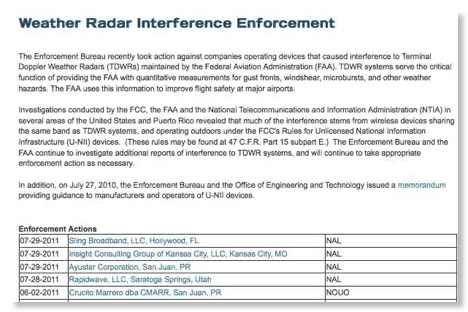
The FCC/EB webpage linked to the picture above now lists 17 FCC enforcement actions related to U-NII interference to FAA TDWR weather radars since 2007. For those not familiar with the jargon here, a March post here reported how 5 GHz unlicensed U-NII equipment operating in the 5.47-5.725 GHz band are required to have dynamic frequency selection (DFS) as defined by 15.407(h), basically a listen-before-talk (LBT) cognitive radio system, in order to avoid interference to several types of federal government radar systems that operate in the same band. The Terminal Doppler Weather Radar, an FAA weather radar near airports, has been receiving interference in several cases despite this requirement. The big question - Why?
NTIA/ITS recently released the second of a 3 part report series that deals with the issue as shown at left. This report has the following interesting quote:
(One)U-NII device was tested against FCC DFS certification waveforms and it did not detect any. It also failed to detect any emulated TDWR waveforms. The device, however, was FCC certified, meaning it had passed these same tests when the FCC laboratory tested its DFS performance. A firmware update from the manufacturer eventually rectified this problem, illustrating how firmware upgrades can lead to DFS non-compliance.
This strongly implies that the manufacturer changed the firmware after FCC approval. While the original FCC software defined radio (SDR) rules would have made such a software change a Class 3 Permissive Change and required regulatory review, the softening of the rules in Docket 03-108 and deletion of the former 2.932(e) gave a green light to such software changes.
Two March 2010 enforcement actions seem to confirm this. These involved Airspan and Motorola. Airspan agreed in a consent decree as follows:
Remedial Measures. Airspan has developed and distributed to its United States MicroMAX customers a software upgrade for its MicroMAXdevice that prevents users from disabling the DFS radar detection mechanism and varying any other operating parameters of the device.
Thus they were selling a unit where the users could turn off the required DFS capability needed to protect safety-related FAA radars! Airspan agreed to make a $10,000 “voluntary payment” to the Treasury as part of the consent decree.
Motorola agreed to a $9,000 “voluntary payment” but their consent decree is more cryptic than the one for Airspan or a similar one for Axxcelera Broadband Wireless, Inc. that appears to be based on a hardware component issue not a software change. The Airspan consent decree has clearly stated “remedial measures” that says what they will correct, Moto gets off with a $1,000 small “voluntary payment” (trivial to what this must have cost in legal fees), a vague agreement to train their employees better:
Motorola will train and provide materials concerning Section 302(b) of the Act and Parts 2 and 15 of the Rules pertaining to U-NII devices and the requirements of the Consent Decree to those of its employees who are involved directly in the development and marketing of U-NII devices imported, marketed and sold by Motorola in the United States.
Cryptically the consent decree states
On April 20, 2009, the Bureau issued an LOI (letter of inquiry) to Motorola. The LOI directed Motorola to submit a sworn written response to a series of questions relating to the marketing and selling of U-NII devices. Motorola responded to the LOI on May 20, 2009.
The content of Moto’s response to the LOI indicating how this happened is not on the public record. This is reminiscent of the “professional courtesy” Moto used to get from FCC when it was the dominant player in the mobile radio field and contrasts with how the lesser firms, Airspan and Axxcelera, were treated - they both paid a greater “voluntary payment” and had their violation more explicitly reported. Moto’s failings are not given in the public document, only in the referenced in the publicly unavailable 5/20/09 LOI response.
The coddling and preferential treatment of Motorola was common in the past but neglects the fact that it may have contributed to Moto’s lack of competitiveness and its ultimate demise as the top mobile radio firm. In the past Moto may have stressed its regulatory prowess over its technical prowess and was not prepared for the level playing field that cellular presented with new competitors. As Trefis reported
Motorola’s market share is expected to decline from a high of 22% in 2006 to 2.8% in 2010, [3] and could continue to decline to 1.6% by the end of Trefis forecast period(2011).
UPDATE
You blogger has filed a FOIA request for the above mentioned Motorola response to the FCC letter of inquiry (LOI) and will publish here the text when received. Today, the following interim response from FCC was received:
Your Freedom of Information Act ("FOIA") request dated August 11, 2011, was assigned to the Commission's Enforcement Bureau. You seek the response to a Letter of Inquiry ("LOI") issued in the Enforcement Bureau's investigation of Motorola, Inc. ("Motorola") (EB-09-SE-064). Motorola responded to the LOI on May 20, 2009. This email is to inform you that Motorola filed a request for confidential treatment of most of its LOI response pursuant to 47 C.F.R. § 0.459 of the Commission's rules. Since the confidentiality request is pending, pursuant to Section 0.461(d)(3) of the Commission's rules, we will serve Motorola with a copy of your FOIA request and afford them 10 calendar days to respond. Motorola also is required to serve you with a copy of its response.
The criteria for withholding such information is given in 47 CFR 0.457(d) . We patiently await word from Motorola if it is willing to let the world know why its equipment violated FCC rules or whether they will fight the release of any substantive information.
Deficit Limits, Budgets and Their Likely Impact on Wireless Innovation at FCC
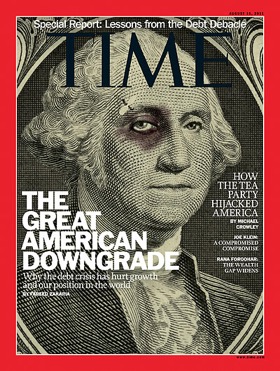
In the 1970’s FCC went twice to the National Academies to ask for policy research studies on major technical controversies that were delaying industry growth. These two studies then became the frameworks of Part 25 Fixed Service/domsat sharing in C band and the Part 68 interconnection rules that opened the floodgates for CPE - units connected to the telephone line.
However, the early Reagan cutback eliminated funding for such studies and slashed technical staffing at FCC. The 8th Floor grew increasingly interested in universal service issues, broadcast ownership and content, and, more recently, in broadband issues. These are all important issues, but so are the technical issue of spectrum policy particularly as they relate to wireless innovation. While is is tempting to see broadband on in terms of repurposing spectrum to me some goal, the needed capacity is a function of spectrum, technology, and infrastructure investment - as was made clear in a recent Ofcom report.
New technology does not emerge spontaneously. Wireless technology is subject to unusual regulatory issues and the complex nature of this and resulting uncertainties is a real discouragement to wireless innovation - something acknowledged by FCC in the Wireless Innovation NOI.
The present spectrum “haves” may well prefer less FCC action in encouraging and considering new wireless technology and thus may be cheering secretly for pending cutbacks in technical policy resources at FCC. But the national interest is not always the interest of the major corporations roaming the halls of the 8th Floor. We all recall when Microsoft, Google, Apple, and RIM where small firms getting little attention among the established firms such as Motorola, RCA, GE, IBM, etc.
The excess time delays associated with many recent decisions in wireless policy, either big decisions like the AWS-3 nondecision after 4 years of deliberations and the similar delays in delays and nondecisions in much less controversial matters ably described by Mitch Lazarus in comments to the Commission, both delay new technology and discourage investment in it vis-a-vis other fields with more transparent regulation.
The 1980s shrinkage in FCC resources was repeated again in the last half of the last decade:
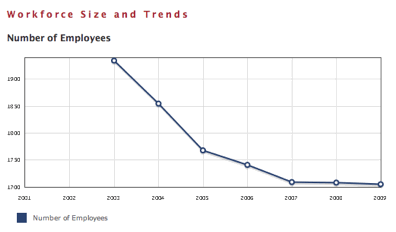 \
\
FCC staffing 2003-1009 (http://bestplacestowork.org/BPTW/rankings/detail/FC00)
Sadly, it is virtually inevitable that the current budget/debt limit mess will lead to the same resource devastation. Much of the FCC constituency, like much of the EPA and SEC “constituencies”, would prefer that their regulatory agencies be cut to allow the “market” to be more effective. Indeed, Indiana Gov. Mitch Daniels calls EPA the “employment prevention agency”. Perhaps it is, but in many of its decisions FCC is the employment creation agency! A one size fits all slashing of agency budgets will adversely affect wireless innovation even if it spares the narrow issue of finding more spectrum for broadband.
NAB and MSTV might view a freeze of all present FCC regulations as being in their interest. CTIA and CEA might want a singleminded focus on more spectrum for broadband and ignoring all other spectrum issues. Indeed, by focusing exclusively on “clearing spectrum” for broadband the impact of broadband on other incumbents will be worse since new technology for either broadband applications or other incumbents, e.g. broadcaster, will be put on hold unless they are lucky enough to be already allowed under today’s anachronistic rules. Capital formation for innovative wireless technology will dry up nearly completely since there will be unpredictable delays in getting FCC action on necessary rule changes/interpretations. Under such circumstances FCC could truly become the “employment prevention agency” agency and wireless innovation would be reduced to making overseas standard making organizations like ETSI the gatekeeper to US spectrum - US startups need not apply without huge capital resources and foreign partners.
If FCC can not get a reprieve from the pending budget ax, let me point out a less desirable alternative that has not been discussed: Making new technology deliberations user fee supported. Note that this is already allowed at FDA for new drug and new device applications, at USPTO for speeding patent applications, and at USNRC for speeding reviews of new reactor technology.
FCC could ask for authority to collect fees for dealing with new technologies that raise interference questions and then use those fees to speed up deliberations by using outside resources to supplement its staff or hire more staff. In exchange for this income, FCC would have to pledge timeliness improvement from its present poor performance in new wireless technology deliberations. This might be done by asking that Section 7 be amended to make it realistic, not an unobtainable goal as at present. While this would make wireless innovation more costly by internalizing the cost of FCC deliberations into a business plan, it may well be more attractive to wireless R&D investor than the present chaos.
But FCC deliberation on innovative wireless technology consistently violate Section 7 under current funding and the expected funding contraction will only make it much worse. Innovators do not expect regulator certainty, but do expect and deserve transparency and timely resolution.
FCC Acts on SpectrumTalk Criticism of Excellence in Engineeing Awards
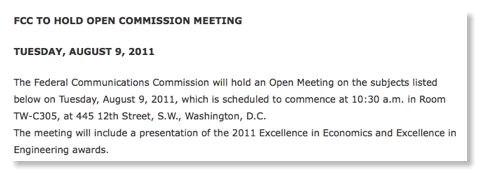
In 2008, this blog had an item entitled “Excellence in Engineering: Why the Secrecy at FCC?” that asked why these awards recognizing excellent engineering work at FCC were given in secrecy while the parallel award for economists was usually announced publicly. In 2009 the awards were announced at a Commission meeting, but never released in writing. The secrecy for these awards has been a recurring theme here at SpectrumTalk. In some years, our spies inside FCC have leaked the names of award recipients and we have recognized them here.
It appears that finally FCC will give public recognition for outstanding work by its engineers.
UPDATE
The presentation took place at the 8/9/11 Commission meeting, but there was no written announcement of the 5 names. Since some of the names have unusual spellings, I am reluctant to give them here for fear of making an error. (The person doing the meeting video captioning apparently did not have a list either and just gave up when some names were announced.) The announcement starts at 49:00 on the video of the meeting and the names and nature of the award winning work are announced at 54:30-58:30 on the video.
An FCC source has provided the names of the award winners - exclusively reported here:
- Chris Andes (WTB)
- Palash Barua (EB)
- Chris Miller (WTB)
- Michael Mullinix (IB)
- George Tannahill (OET)
From FCC to White House
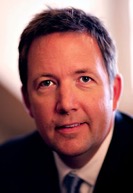
Steven L. VanRoekel is currently the Executive Director of Citizen and Organizational Engagement at the United States Agency for International Development (USAID). Before moving to USAID in 2011, he served as Managing Director of the Federal Communications Commission (FCC), where he oversaw all operational, technical, financial, and human resource aspects of the agency. He also led the FCC's efforts to introduce new technology and social media into the agency. Mr. VanRoekel worked at Microsoft Corporation from 1994 to 2009, most recently as the Senior Director for the Windows Server and Tools Division. He received a B.A. in Management of Information Systems from Iowa State University.
NYTimes added the following details
Oddly, when he left FCC there were staff rumors that he fell out of favor because of the controversy over the new FCC website, which your blogger had defended. Clearly either such rumors are wrong or he is still in favor in other circles.Mr. VanRoekel worked for Microsoft for 15 years, including a stint as an assistant to Bill Gates, the co-founder. Mr. VanRoekel was a supporter of President Obama, attended the inauguration, and after a conversation with Julius Genachowski, the new chairman of the F.C.C., went to work for him.
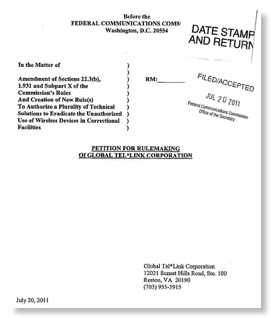

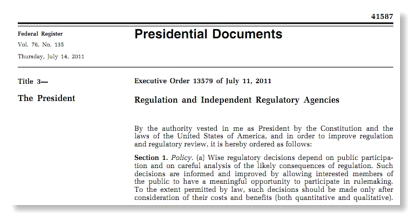
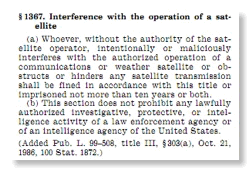
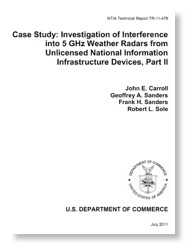



![Validate my RSS feed [Valid RSS]](valid-rss-rogers.png)

